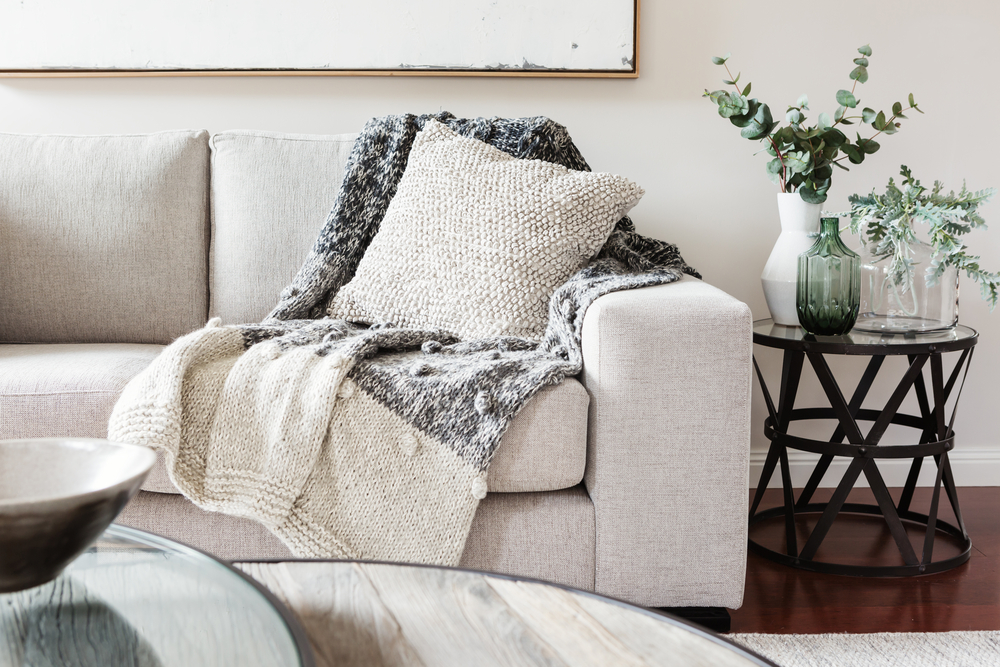Leather sofas can be some of the most durable sofas around, especially real leather ones. They only require a little bit of maintenance now and again to stay looking pristine helping them to last for a lifetime.
Even the scuffs and scratches from any pets that have will add to the character of the leather sofa without making it look too shabby.
If you’ve got a leather sofa and you’re looking for some more natural ways to keep it looking lovely, then this article will give you some of the best hints and tricks.
Sometimes though, natural is not always best and your leather sofa will require some sort of store-bought or chemical formula to keep it in top condition, so we’ll also be giving some recommendations of what to use on your leather sofa.

So, how can I clean my leather sofa naturally?
Sometimes it is better to avoid using harsh chemicals that can strip the color of your sofa or even damage the material on the surface.
If you’re going to clean your sofa naturally, then you’ll want to take action as soon as any stains or spillages occur, otherwise you risk them becoming permanent on the material.
White vinegar is one of the best natural products to use on your leather sofa if you spill something on it or spot a stain. It’s very commonly used on all upholstery due to its acidic nature that can break down compounds.
Make a solution of equal parts water and vinegar in a glass, dip a clean microfiber cloth into the solution so it’s damp but not wet and start blotting the affected area.
With another clean cloth start wiping the stain away, if you don’t have a spare cloth then use a clean part of your current one and make sure you’re not wiping any of the removed stains back into the leather.
The white vinegar may leave a lingering smell on the leather if you don’t go in afterward with another natural treatment.
Make a solution of some mild detergent and lukewarm water (if the vinegar is very strong try using a stronger fragrance detergent) and blot the area again with the solution on a damp cloth and then leave to air dry.
If you’re concerned that the white vinegar might hinder the quality of your leather sofa, then try doing a patch test somewhere conspicuous on the sofa to make sure nothing happens.
Some leather sofas may react differently to homemade and chemical cleaning solutions. Check the labels on your sofa to see what they recommend cleaning it with.
How can I polish my leather couch?
One of the most simple ways to polish your leather couch is to use leather wipes or leather polishing spray from a store as they’ll be formulated to perfectly clean and polish the material of your sofa without damaging it.
Before you think about polishing your leather couch, you should go in first with a vacuum cleaner that comes with the brush or upholstery attachment.
Take all the pillows that you can and go around the edges and the folds where debris or grime could be settled. You can also use a feather duster to remove excess dust to make sure you’re not rubbing the dust back into the leather when you polish it.
If you don’t have any leather polishing wipes or spray around, then you can also try using baby wipes to polish your sofa as they’re gentle but will still ensure that any bacteria or grime is removed.
A homemade cleaning solution for polishing your leather couch to keep it looking clean and shiny is using white vinegar and warm water.
Combine equal parts of both and then dip a clean cloth into the solution, making sure to wring it out so it’s not saturated - too much liquid can damage the leather material.
Wipe your sofa all over with the cloth and the combined cleaning solution in circular motions, making sure to do the armrests, back and sides of the sofa and then wipe it dry with a microfiber cloth.
Do not use a hairdryer to speed up the drying process as this will dehydrate the leather and cause it to wrinkle.
Do not use any varnish or furniture polish on your leather sofa as this can leave a sticky residue on the leather. Make sure to check the labels on all cleaning products you plan to use on your leather sofa to make sure they’re safe.
How do I condition my leather sofa naturally?
Cleaning will ensure there’s no build of bacteria or grime living on your sofa, but it’s conditioning that will keep it looking brand new with that sheen appearance. You can naturally condition your leather sofa without having to use any chemical cleaning products (but you can do so if you wish).
Mix a solution of equal parts white vinegar and lemon oil and then dip a microfiber cloth into the solution but make sure to saturate it.
Gently begin wiping down the surface all over the sofa and then leave the solution to settle overnight (make sure any pets are locked away from the room so they don’t sit on it). Then wipe the sofa down with a clean cloth the next day.
If you don’t have lemon oil then you can also use tea tree oil or flaxseed oil. We recommend tea tree or lemon as they’ll leave a more pleasant odor on your sofa once it’s been wiped dry.
Every time you polish or clean your sofa, you should make sure to follow up with a leather conditioner as water-based cleaning solutions can dry the leather out and cause it to crack.
How do you clean a black leather chair?
If you need to clean a black leather chair, then you’d follow the same process that you would for cleaning any other kind of leather chair or sofa.
Using mild dish soap and water solution/white vinegar and water solution, dip a microfiber cloth into the solution and wring it out so it’s damp, not wet. Rub all over the sofa if you’re cleaning all the surface or blot an affected area to try to remove any stains.
Then wipe it over with a clean cloth to remove the solution and leave it to air dry. You’ll want to follow up with a leather conditioner to prevent the material from cracking from the water-based cleaning solutions you use.
How do you get body oil out of a leather couch?
If you’ve got body oil or any other kind of grease stain on your leather couch, then you’ll want to act as soon as possible to try to remove as much oil as possible.
One method you can use is adding some baking soda to a damp cloth and dabbing it on the affected area and leaving it to sit on there for a few hours to absorb the oil. Then once it’s dried, dust it off with a clean cloth or lightly brush it.
You can also use talcum powder as an alternative to baking soda. Leave the talcum powder on the greased area overnight and then wipe it off with a clean damp the morning after and leave to air dry.
How do you rejuvenate a leather sofa?
If your sofa has been exposed to direct sunlight for years and the color of the leather has started to fade, then you may be able to use a leather restoration cream that comes in various colors and shades to rejuvenate your leather sofa.
It can only be used on leather sofas that absorb liquids or creams so it won’t stain your clothes when you sit on them.
The best way to rejuvenate the sofa is to keep up with the maintenance. Regularly cleaning it with a solution to remove any bacteria or build-up on the surfaces.
Using a vacuum cleaning to suck up the debris that could be hidden in crevices. If you’ve got stains you can use white vinegar and warm water to help get rid of them.
If you’ve got bad scratches or the leather has split, you can use leather glue to help patch it back together. You’ll need to hold the split closed whilst the glue dries to make sure that it sticks back together seamlessly.
You can use a leather colorant or binder on your sofa once a year if it’s beginning to look very worn down. You’ll want to make sure to do this in a ventilated room as these products can have strong fumes.
What do you clean leather sofas with?
You can easily clean your leather sofa and keep it in good condition by using white vinegar and water solution on a cloth to wipe down the surfaces every 2 weeks to ensure there’s no build of grime or bacteria.
You should also try to vacuum the sofa every 2 weeks, making sure to remove all pillows and seats so you can reach hidden crevices.
If you’ve got pets or young children who eat and lounge around on the sofa, then bad odors can begin to develop over time. You sprinkle baking soda all over your leather sofa to help absorb all the odors and then leave it 15 minutes before vacuuming it up.
How to cure scratches on a leather sofa?
Whilst leather is pretty long-wearing, it can still suffer some scratches or marks from pets jumping up and down from them.
If you notice any scratches on your sofa, you should clean the area with some white vinegar solution (like we recommended above) and then dry the area with a clean cloth.
Then use a mild oil (baby oil will do) to a cotton ball and gently rub the scratch in circular motions and then wipe away the oil. Let the scratch air dry.






